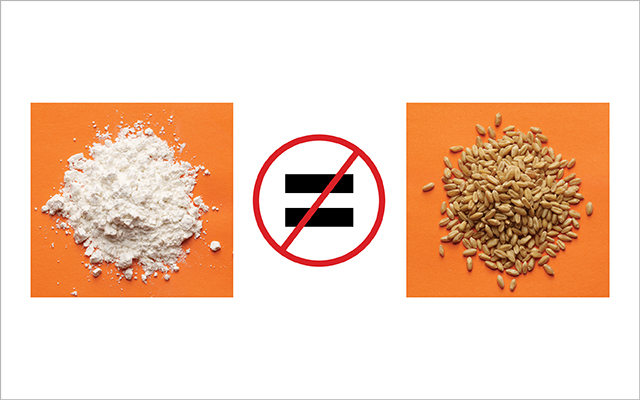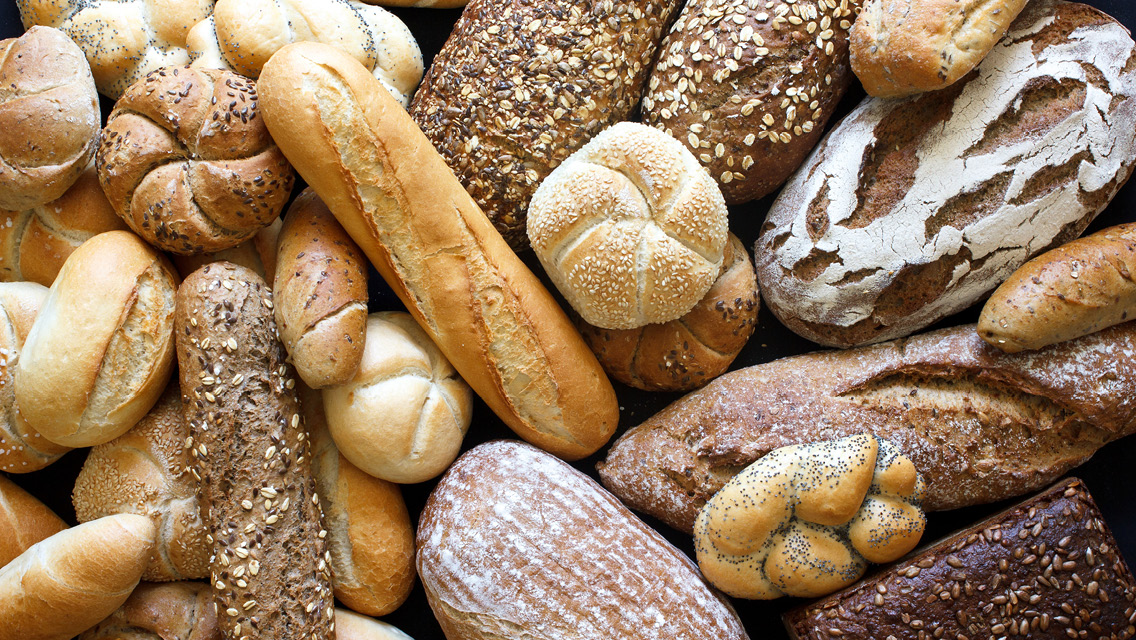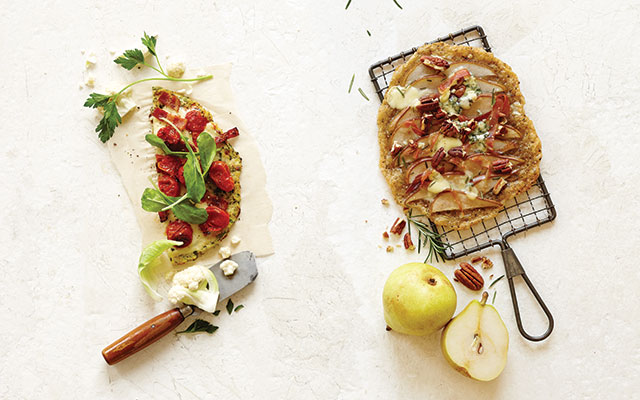Flour is hard to sidestep come mealtime. Breakfast brims with toast, bagels, cereal, pancakes. Lunch is built around sandwiches, wraps, pasta, pizza. And dinner may come with its very own breadbasket.
Flours are produced by crushing grains into fine powders. And those powders form the basis not just for breads and buns, but for a huge variety of processed foods, from cereals, crackers and pizza dough to cookies, cakes and ice cream cones. As a result, the average American now eats 10 servings of refined grains each day.
Are Refined Grains Bad for You?
As our national appetite for flour has inched up, so has the incidence of diet-related ills, such as obesity, heart disease and diabetes. Coincidence? Many nutrition experts don’t think so. When they weigh the evidence linking food choices and disease, they see the white, dusty fingerprints of flour everywhere.
“Now that trans fats are largely out of the food supply,” says David Ludwig, MD, PhD, director of the New Balance Foundation Obesity Prevention Center at Children’s Hospital Boston, “refined carbohydrates, including refined grain products, are the single most harmful influence in the American diet today.”
Flour started out as an ingenious fix to a vexing problem. Grass seeds were plentiful, but the tough outer shell (the husk) made the seeds difficult to chew and digest. Early humans outsmarted the seeds by grinding them between stones, crushing the outer layers to get at the goodness inside. The result — a coarse powder — was the first whole-grain flour.
The downside was spoilage. Crushing the germ released its oils, which quickly turned rancid when exposed to air. With the advent of industrial milling in the late 1800s, machines began filtering out the germ and pulverized the remaining endosperm into a fine, white powder that lasted on the shelf for months. And so all-purpose white flour was born — along with a host of health problems.
Beneath their rigid architecture, whole-kernel grains conceal an array of vitamins, minerals, phytonutrients and fiber. But when machines pulverize kernels into flour, even whole-grain flour, what’s left behind is a starchy powder capable of wreaking havoc on the body.
What Is the Difference Between Whole Grains and Refined Grains?
Flour, as opposed to whole-kernel grains, is easy to overconsume because most flour-based foods require little chewing and go down rather quickly. “It is so much easier to overconsume any food where the work of chewing or digesting or separating fiber from starch has been done for us,” says functional nutritionist Julie Starkel, MS, MBA, RD.
Overconsuming flour can lead to a number of problems in the body, including:
Blood-Sugar Blues. Smashing a whole-kernel grain to smithereens means it digests faster. Rapid-fire digestion causes blood sugar to spike, which causes a rise in insulin. The result? Not only are you hungry two hours later, but you are also paving the way for insulin resistance and diabetes. “The difference between a whole-kernel grain and a processed grain all boils down to the glycemic index, which is how quickly the body turns food into fuel, or glucose,” says Gerard Mullin, MD, FACN, director of integrative gastroenterology nutrition at Johns Hopkins Hospital in Baltimore, Md., and coauthor of The Inside Tract: Your Good Gut Guide to Great Digestive Health (Rodale, 2011). Foods made with wheat flour are particularly damaging. A carbohydrate in wheat, called amylopectin A, is more easily converted to blood sugar than just about any other carbohydrate. Two slices of bread made with whole-wheat flour raise blood sugar higher than six teaspoons of table sugar and higher than many candy bars.
“If we were evil scientists and we said, ‘Let’s make the most perfect poison,’ it would be wheat,” says preventive cardiologist William Davis, MD. (For more on why Davis advises against eating any kind of wheat — including even whole-kernel grains — check out his book, Wheat Belly: Lose the Wheat, Lose the Weight and Find Your Path Back to Health (Rodale, 2011).)
Food Cravings. Over the past 50 years, the amber waves of grain our grandparents enjoyed have been replaced with modern, high-yield dwarf strains of wheat that produce more seeds and grow faster. The result is a dietary wild card, says Davis: “Agricultural geneticists never asked if these new strains of wheat were suitable for human consumption. Their safety has never been tested.” One of the biggest changes in modern wheat is that it contains a modified form of gliadin, a protein found in wheat gluten. Gliadin unleashes a feel-good effect in the brain by morphing into a substance that crosses the blood-brain barrier and binds onto the brain’s opiate receptors. “Gliadin is a very mind-active compound that increases people’s appetites,” says Davis. “People on average eat 400 more calories a day when eating wheat, thanks to the appetite-stimulating effects of gliadin.”
Caloric Overload. By definition, a refined grain packs more calories than a whole-kernel grain because it is more concentrated. And foods that are high in grains also tend to be high in sugar and industrialized fats. These are the foods, say many experts, that are causing our obesity and diabetes epidemic.
Metabolic Slowdown. Research shows that the body may shift nutrients into fat storage and away from muscle burning in the presence of high-glycemic-index foods. In 2004, Ludwig and his colleagues at Harvard conducted a study, published in the journal Lancet, in which they fed rats diets with identical nutrients, except for the type of starch. By the end of the study, rats in both groups weighed roughly the same, but those eating a high-glycemic diet had 71 percent more fat than the low-glycemic-index group.
Inflammation. A diet high in grains stokes inflammation. When blood sugar spikes, glucose builds up in the blood like so many standby passengers on a flight. When glucose loiters in the blood, it gets into trouble by attaching itself to nearby proteins. The result is a chemical reaction called glycation, a pro-inflammatory process that plays a role in a host of inflammatory diseases — everything from cataracts to arthritis to heart disease.
GI Disorders. Studies show that the lectins in grains inflame the lining of the gut and create fissures between cells. Also, when whole-kernel grains are refined, 80 percent of the fiber is lost, and gut health suffers. “Without the fiber, you end up with rapid-release carbs in these grains, which is a bad thing for the gut,” says Kathie Swift, MS, RD, coauthor (with Mullin) of The Inside Tract. Plus, fiber helps sweep the gut of debris and supports the body’s critically important elimination and detoxification processes, which also play a role in keeping high cholesterol and inflammation at bay.
Food Allergies/Intolerances. Wheat, in particular, is one of the biggest dietary triggers of food allergies and intolerances. While the exact reason is unclear, many experts blame the higher gluten content of modern wheat varieties. A type of protein found in many grains, including wheat, gluten gives dough elasticity, trapping air bubbles and creating a soft texture. Because soft is considered desirable, wheat today is bred to have more gluten than ever before.
Acid-Alkaline Imbalance. The body has an elaborate system of checks and balances to keep its pH level at a steady 7.4. A diet high in acidic foods, such as grains, forces the body to pull calcium from the bones to keep things on an even keel. When researchers looked at how the diets of more than 500 women affected their bone density, they found that a diet high in refined grains, among other nutrient-poor foods, was linked to bone loss. A highly acidic diet also chips away at our cellular vitality and immunity in ways that can make us vulnerable to chronic disease. “Grains are the only plant foods that generate acidic byproducts,” says Davis. “Wheat, in particular, is among the most potent sources of sulfuric acid, a powerful substance that quickly overcomes the neutralizing effects of alkaline bases.”
This article has been updated. It originally appeared as “A Grain of Truth” in the July/August 2012 issue.
Flour From Head to Toe
A diet high in flours made from wheat or other grains affects every system in the body. Here’s a quick guide to flour’s far-reaching effects.
Brain: The proteins in wheat directly affect the brain. Able to cross the blood-brain barrier, wheat-derived substances attach to the brain’s opiate receptors and trigger appetite and cravings.
Blood: Levels of sugar in the blood spike within a few short minutes of eating foods made from flour. The chains of simple sugars, especially those in wheat, cause a greater spike in blood sugar than virtually any other food, including table sugar.
Pancreas: The pancreas has to crank out a lot of insulin to metabolize the glucose in flour-rich foods, which can set the body up for insulin resistance, diabetes and bodywide inflammation.
Waistline: Over weeks and months, the yo-yo effect of rising and falling blood sugar and insulin levels increases the body’s fat storage around the abdomen. Called visceral fat, this extra padding is hormonally active, churning out a disruptive array of inflammatory signals and even sex hormones, such as estrogen.
Gut: The cells that line the walls of your intestines form a tightly woven barrier. But a protein called zonulin can create chinks in the body’s intestinal armor, allowing particles of food to pass through the gut’s lining undigested. Wheat contains a protein called gliadin that causes excess production of zonulin. As a result, the body’s immune system goes into chronic overdrive. Food allergies and sensitivities (with an array of attendant digestive and skin conditions) may develop as a result of gut inflammation.
Colon: Over time, the blood-sugar highs and lows that result from a flour-rich diet can damage nerve cells that drive gut motility. Eventually, transit time slows and traffic backs up.
|
Guide to a Whole Grain
For a food to be labeled “whole grain,” it must contain all the edible components of the entire grain kernel, including the bran, the germ and the endosperm. But don’t let the word “whole” fool you. It doesn’t refer to the intactness of the kernel or its nutrition. In their unadulterated state, whole kernels of grain contain a rich variety of nutrients. When machines grind, crack, flake, puff or pulverize kernels into flour, those nutrients take a hit and may disappear altogether. Additionally, says functional medicine nutritionist Julie Starkel, MS, MBA, RD, “the beneficial oils in the grain, once exposed to oxygen, heat and light, will oxidize or become rancid very quickly.” What’s left behind is a calorie-dense, nutritionally compromised, high-carbohydrate food primed to increase your risk of heart disease, diabetes and weight gain.
Husk
The outermost layer of a grain, the husk is inedible. Not present in whole-kernel grains or whole-grain and refined (white) flours.
Bran
A protective barrier that helps ward off predators, such as bacteria, viruses and fungi, the bran contains fiber, B vitamins and trace minerals. Present in whole-grain flours but not refined flours.
Endosperm
The endosperm is mostly starchy carbohydrate that acts like a sugar in the body. Present in both whole-grain flours and refined flours; refined flour is, in essence, the pulverized endosperm of a grain with everything else removed.
Germ
The germ contains antioxidants, vitamin E, B vitamins and polyunsaturated fatty acids. The beneficial oils in the germ are prone to rancidity once exposed to air. Present in whole-grain flours but not refined flours.|
7 Steps Away From Refined Grains
Whole grains deliver fiber, healthy fats, vitamins, minerals, plant enzymes and hundreds of phytochemicals. For those seeking a dense source of carbohydrate energy, they can be a healthy choice — but only if they are unrefined and minimally processed. Here are a few steps toward upgrading your own grain options.
1. Choose whole-kernel grains when possible. Whole-kernel grains, such as wild rice, quinoa, millet, buckwheat groats, hulled barley and whole-wheat berries, are what Ludwig refers to as “unbroken grains.” Unbroken grains have heartier, more complex structures than pulverized and processed ones, making them slower to digest, less disruptive of blood sugar and better at satisfying hunger for an extended period of time. Minimally processed grains, such as steel-cut oats, are another good option.
2. Try sprouted grains. Sprouting activates beneficial enzymes, which transform grains from static seeds to living foods. Sprouting changes the seed’s starch, converting it into maltose. Ordinarily, this conversion happens during the first stage of digestion. So, sprouting is a form of predigestion. For that reason, foods made with sprouted grains are thought to be easier to digest and, therefore, their nutrients more easily absorbed than foods made with conventional grains. Sprouted grains also tend to be higher in protein, which can help regulate the rate at which the grains’ sugars are metabolized.
3. When you bake, replace part of the flour with nut or seed meals. Meals made from ground nuts and seeds, such as almonds, cashews, coconut and flax, can often stand in for flour in baking recipes as well as breadings on meats or seafood. Compared with many flours, nut and seed meals are higher in protein and lower in carbohydrates. “Nut and seed meals are an easy way to upgrade the nutritional profile of your favorite flour-based foods,” says nutritionist Kathie Swift, MS, RD.
4. Stick with truly whole-grain flours. To be labeled “whole grain,” the entire contents of the original kernel must be present, meaning the bran, germ and endosperm. The downside is that they are still processed. The glycemic index of whole-grain flour is roughly the same as white flour. The upside is that it is nutritionally superior because it retains the kernel’s original nutrients, including at least some of the antioxidants, which can combat the inflammatory stress of eating the flour, says David Ludwig, MD, PhD. When buying products made with whole-grain flours, prioritize those with a variety of grains (say barley, buckwheat and oats) to get a wider variety of nutrients.
5. Don’t overdose on gluten-free foods. In response to a growing market for gluten-free products, food companies are marketing alternatives to wheat flour. Unfortunately, many of the options they choose, such as potato flour, rice flour and tapioca starch, digest even faster than wheat flour and, therefore, may exacerbate many of the health issues they promise to quell. Many gluten-free goods lack fiber and deliver a megadose of sugar, says Swift. “I caution my clients to tread lightly when it comes to gluten-free products.”
6. Try going flour-free. Ditch all flour-based foods for a week and see how your body responds. Swift has many of her clients start going flour-free for five days. Avoiding flour, even for this short time, can help restore balance in the body by stabilizing blood sugars, soothing inflammation and increasing gut motility, she says. “I see amazing results when people give up flour.”
7. Consider a grain sabbatical. Not everyone agrees that grains are essential, or even beneficial, for health. Ludwig points out that humans rarely ate grains before the advent of agriculture. “The human requirement for grain is zero,” he says. William Davis, MD, agrees: “The promotion of ‘healthy whole grains’ in the diet by the government, dietitians and physicians will go down as the biggest nutritional blunder ever made.” One benefit of avoiding grains or even just dialing back your intake of them is that it gives you room and reason to include a rich variety of other, more nutritious whole foods, like dark leafy greens, squash, sweet potatoes, nuts, seeds and legumes. And for that, your body will thank you.




This Post Has One Comment
Please comment on the find-grinding of spices, e.g., that jar of ground cinnamon in my pantry, or the garlic powder. Is it better to have a courser grind in terms of how our bodies process spices?
Thank you.